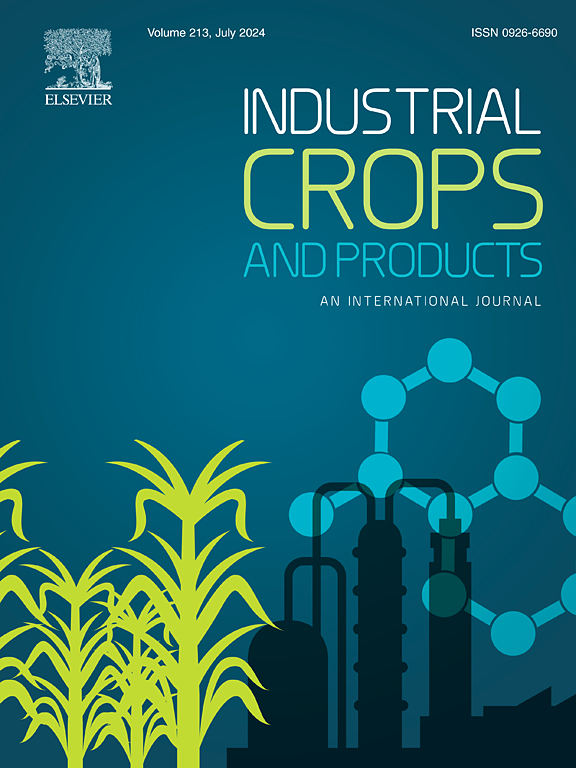Isolation of cellulose microfibers from banana plant residues and their conversion into sustainable and biocompatible 3D printable hydrogels for drug delivery
IF 5.6
1区 农林科学
Q1 AGRICULTURAL ENGINEERING
引用次数: 0
Abstract
Cellulose microfibers extracted from banana plant residues were used to develop sustainable hydrogels by dissolving them in a sodium hydroxide-urea solvent and cross-linking with epichlorohydrin. Three formulations (2 %, 3 %, and 4 % w/v cellulose microfiber content, designated as 2CH, 3CH, and 4CH) were synthesized and evaluated for their structural, mechanical, and biological properties. The lyophilized hydrogels exhibited highly macroporous structures (>90 % porosity). Increasing microfiber concentration led to greater chain entanglement, reducing the equilibrium swelling ratio by approximately 1.5-fold per 1 % increase in microfiber content. The hydrogels showed soft yet flexible mechanical behavior, with compressive moduli of 100 ± 42 Pa (2CH) and 625 ± 91 Pa (4CH), and exhibited viscoelastic properties, including shear-thinning and thixotropic recovery. Enzymatic biodegradation studies over 28 days revealed higher degradation for 2CH (93.47 ± 2.63 %) compared to 3CH (77.04 ± 2.17 %) and 4CH (66.44 ± 3.47 %), indicating that increased microfiber content enhanced the stability. The hydrogels demonstrated excellent cytocompatibility with HaCaT (keratinocyte), McCoy (fibroblast), and THP-1 (monocyte) cells. Additionally, hydrogel facilitated the cell attachment and proliferation of McCoy and THP-1 cells. Immunocompatibility of developed hydrogel was confirmed through the retention of mononuclear morphology of THP-1 cells cultured on hydrogel and CD14 immunostaining assay. Beyond this, the hydrogels significantly promoted fibroblast migration when checked by transwell co-culture. Notably, the 3CH hydrogel exhibited superior 3D printability and controlled drug release potential, making it a promising candidate for skin-related biomedical applications. Overall, this study highlights the potential of cellulose microfiber-based hydrogels as sustainable, biocompatible materials with tunable properties for implantable medicines and soft tissue engineering.

从香蕉植物残基中分离纤维素微纤维,并将其转化为可持续性和生物相容性的3D打印水凝胶,用于药物输送
从香蕉植物残体中提取纤维素微纤维,将其溶解在氢氧化钠-尿素溶剂中,并与环氧氯丙烷交联,制备可持续水凝胶。合成了3种配方(2 %、3 %和4 % w/v纤维素微纤维含量分别为2CH、3CH和4CH),并对其结构、力学和生物学性能进行了评价。冻干水凝胶表现出高度的大孔结构(>;90 %孔隙率)。增加超细纤维浓度导致更大的链缠结,每增加1 %的超细纤维含量,平衡膨胀率降低约1.5倍。水凝胶表现出柔软而灵活的力学行为,压缩模量为100 ± 42 Pa (2CH)和625 ± 91 Pa (4CH),并表现出剪切减薄和触变恢复等粘弹性特性。酶生物降解研究/ 28天显示更高的降解2 ch(93.47 ±2.63 %)相比,3 ch(77.04 ±2.17 %)和4 ch(66.44 ±3.47 %),表明超细纤维含量增加提高了稳定性。水凝胶与HaCaT(角质形成细胞)、McCoy(成纤维细胞)和THP-1(单核细胞)具有良好的细胞相容性。此外,水凝胶促进McCoy和THP-1细胞的附着和增殖。通过水凝胶培养THP-1细胞的单核形态保留和CD14免疫染色,证实了水凝胶的免疫相容性。除此之外,经transwell共培养检查,水凝胶显著促进成纤维细胞迁移。值得注意的是,3CH水凝胶具有优越的3D打印性能和药物释放控制潜力,使其成为与皮肤相关的生物医学应用的有希望的候选者。总的来说,这项研究强调了纤维素微纤维基水凝胶作为可持续的、生物相容性的材料的潜力,这种材料具有可调的性能,可用于植入式药物和软组织工程。
本文章由计算机程序翻译,如有差异,请以英文原文为准。
求助全文
约1分钟内获得全文
求助全文
来源期刊

Industrial Crops and Products
农林科学-农业工程
CiteScore
9.50
自引率
8.50%
发文量
1518
审稿时长
43 days
期刊介绍:
Industrial Crops and Products is an International Journal publishing academic and industrial research on industrial (defined as non-food/non-feed) crops and products. Papers concern both crop-oriented and bio-based materials from crops-oriented research, and should be of interest to an international audience, hypothesis driven, and where comparisons are made statistics performed.
 求助内容:
求助内容: 应助结果提醒方式:
应助结果提醒方式:


